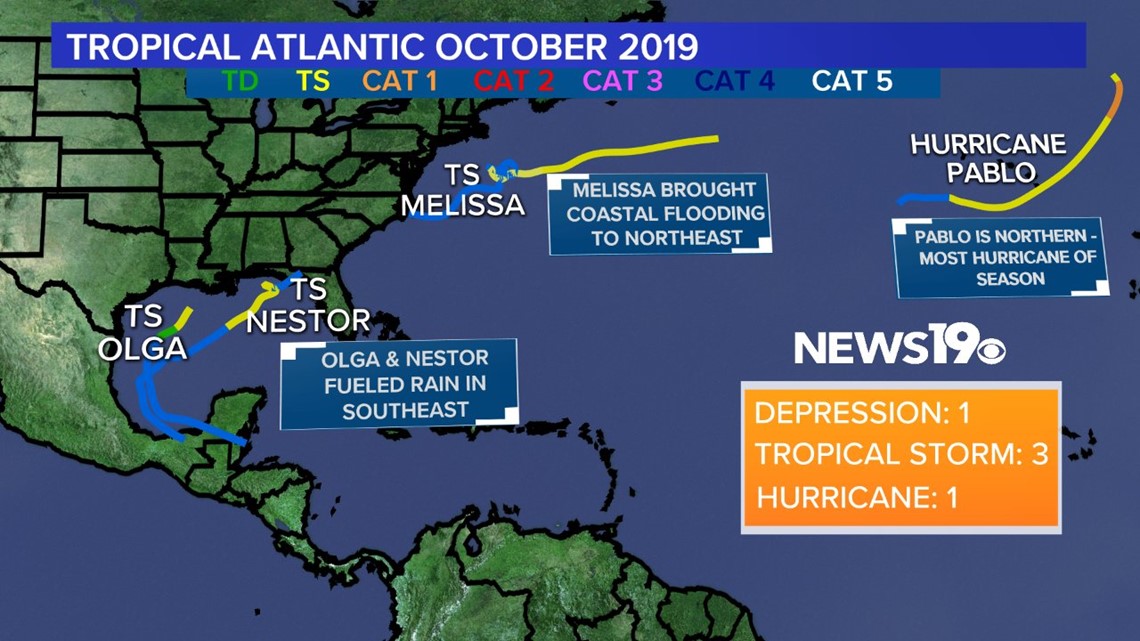COLUMBIA, S.C. — October started off quiet, but ended as another another active month in the 2019 Atlantic Hurricane season with 6 new tropical systems. These were all very short lived disturbances, surviving three days at the longest.
Tropical Storm Melissa (October 11 - 14)
This system developed off the Mid-Atlantic coast as a non-tropical area of low pressure that developed subtropical characteristics on October 11th and then briefly developed into an organized tropical storm on October 12th about 300 miles southeast of Nantucket, MA. Melissa had maximum sustained winds of 65 mph, but never made landfall. The storm's impact was felt across the Mid-Atlantic and Northeast in the form of coastal flooding during high tide.
Tropical Depression 15 (October 14 - 16)
Tropical Depression 15 developed off the east coast of Africa as a cluster of thunderstorm activity emerged from the African interior. These "Cabo Verde type storms" are more typical in July though September when thunderstorm activity in this part of Africa is more frequent. Tropical Depression 15 lost organization just 36 hours after the first advisory from the National Hurricane Center.
Tropical Storm Nestor (October 17 - 19)
Nestor began in the southern Gulf of Mexico as a cluster of thunderstorms that was declared a "Potential Tropical Cyclone" by the National Hurricane Center on October 17th. Although the system had not organized into a tropical system, the "potential tropical cyclone" label gave the National Hurricane Center the ability to issue Tropical Storm Warnings for the northern Gulf of Mexico. The storm continued to organize and was labeled "Nestor" on October 18th reaching maximum sustained winds of 60 mph. Less than 24 hours later, Nestor lost tropical characteristics and then made landfall on the Florida Panhandle that afternoon near St. Vincent Island.
Nestor's outer bands brought significant severe weather to Central Florida. Several tornadoes were recorded in the state. The strongest was an EF-2 in Kathleen, FL with estimated winds of over 111 mph. The remnants of Nestor brought much needed rain to parts of the southeast, but also spawn an EF-1 tornado near Myrtle Beach which damaged several homes.
Tropical Storm Olga (October 25)
If you blinked, you would have missed Olga. The storm developed into a tropical storm in the Gulf of Mexico on October 25th and dissipated a few hours later when it merged with a cold front.
Hurricane Pablo (October 25- October 28)
On October 25th, the National Hurricane Center declared Pablo a very small Tropical Storm with tropical storm force winds only extending up to 35 miles from the storm center. On Sunday morning, October 27th, Pablo became a hurricane over chilly 60 degree waters, which is highly unusual. The storm reached estimated maximum sustained winds of 80 mph and then began to weaken Sunday. The storm was a hurricane for less than 1 day, but was the northernmost hurricane of the Atlantic 2019 Hurricane Season.


What's Next?
Hurricane Season officially ends on November 30th, but activity in the tropics is often very minimal in the month of November. No tropical systems developed in November 2018 in the Atlantic Basin. Major hurricanes in November are extremely rare, but are not unheard of. In 2016, Hurricane Otto reached major hurricane status and made landfall in Nicaragua. Otto managed to survive and continue as an eastern Pacific storm, which is rare.
Typically, if a tropical system develops, it's in the Caribbean Sea or over the Central Atlantic.

